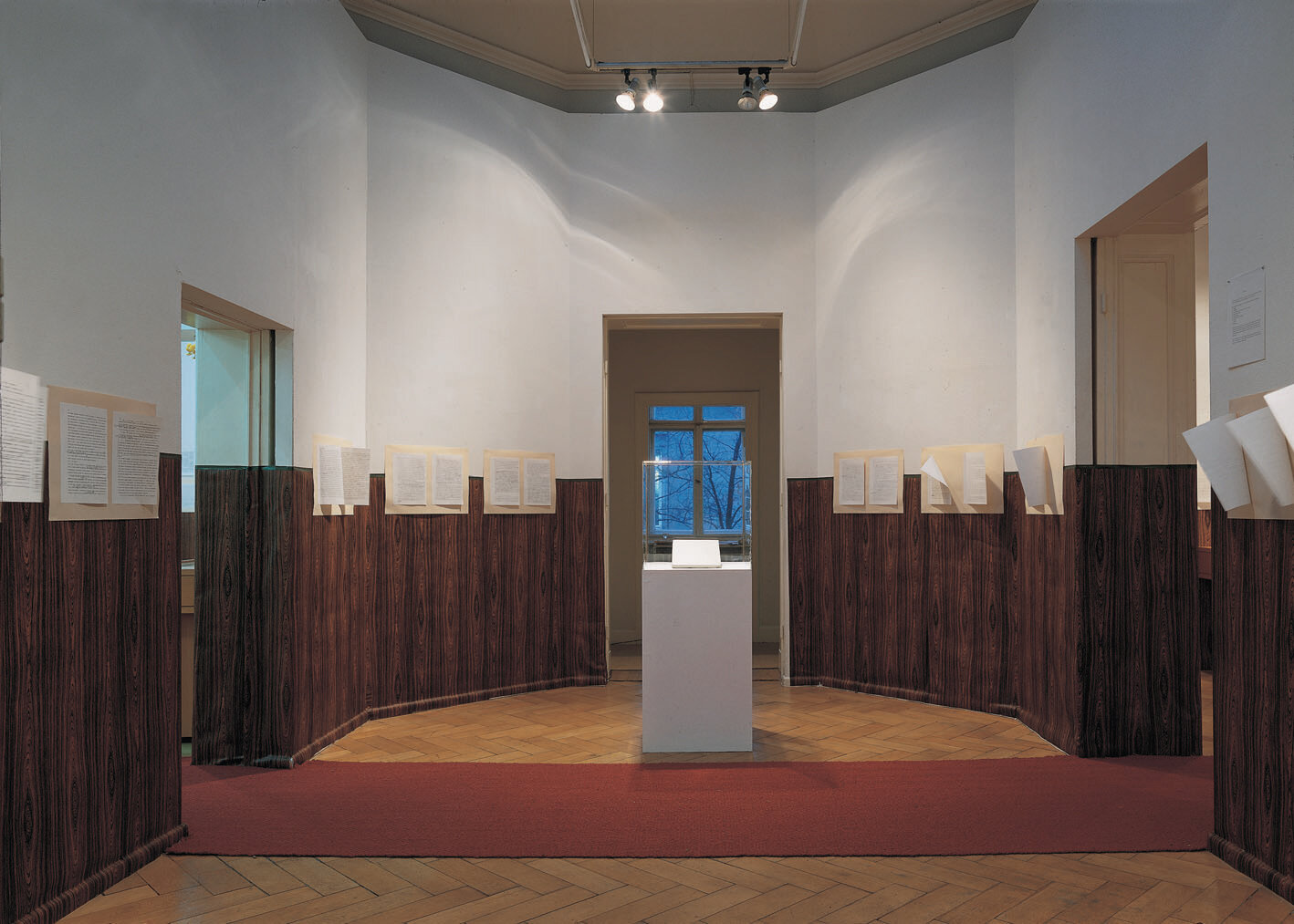Exhibition of a Book
YEAR: 1989
CATALOGUE NUMBER: 29
NOTES
See No 90
PROVENANCE
Collection of the artist
EXHIBITIONS
Berlin, daad-Galerie
Ilya Kabakov. Ausstellung eines Buches 9 Dec 1989 — 28 Jan 1990
Hamburg, Leporellos und Zeichnungen, Deichtorhallen
Ilya Kabakov. Der Lesesaal – Bilder 19 Apr 1996 — 28 Jul 1996 (Selection, as part of No 90, The Reading Room)
DESCRIPTION
The installation belongs to the type of ‘very large installations,’ since it unites a few smaller installations. In the form in which it was displayed in the daad Galerie in Berlin, it represents a system of five comparatively small rooms: one in the middle and two on either side. The rooms were transformed into a provincial Soviet library: the walls of all the dwellings, from the floor to the middle of the wall, were covered over with dark ‘fake wood’ wallpaper. A red carpet was run through all the rooms, and heavy, old-fashioned wooden display cases were arranged near the wall. The exhibit began with the central small room, where the book itself was displayed to which the entire exhibit was dedicated, and of which the entire exhibit served as an illustration. Strictly speaking, the entire exhibit was an expanded illustration to the book. The manuscript version of this book – a dialogue between Boris Groys and Ilya Kabakov – is glued to the walls of all the rooms at eye-level. The dialogue is built around nine topics. Each theme was transformed into a separate installation consisting of the photographs, drawings, and texts hanging on the walls and the objects lying in the display cases. If you imagine to yourself that the manuscript pages ‘running’ horizontally along the wall resemble a ‘railroad,’ then these nine small installations look like stations on a long route that passes through all the rooms.
ARTIST`S COMMENTS
One other memory of childhood and youth is of visiting the library and sitting there for long hours at one of the long wooden tables. Silence. All around you in a virtually empty hall, a few people of different ages are sitting there essentially motionless, and to the right of each one is a pile of books. No one pays attention to anyone else, everyone is engrossed (or it seems they are engrossed) in reading. I submerged myself not so much in reading, because given my absent-minded nature often I couldn’t concentrate for a long time and I would get distracted, but more so I would look at others’ books, I would look all around, at the walls, at all kinds of exhibits set up along the walls, at the glass display cases…
As a rule, thematic displays lined the walls (I am talking about ‘the bygone ’50’s’): a selection of books on a certain topic, usually coinciding with some anniversary dates, for example, ‘The Patriotic War of 1812,’ ‘100-year Anniversary of Watt’s Steam Machine,’ ‘The Pugachev Uprising.’ But more often it was to commemorate the dates of birth and death of poets, writers, public figures: books were arranged in display cases, manuscript pages under glass hung on the walls along with their photographs bearing dedicatory inscriptions, illustrations, views of the cities where the luminaries were born and lived. A large portrait of the anniversary person would be placed in the center and a bit above everything else. All of this was grouped according to specific periods in the person’s life: childhood, youth, university days, travels, and then the ‘major works’ (each work had its own stand with illustrations), and, finally, a concluding section uniting the final years and death. This material, as far as I can remember, was usually arranged along the entire perimeter of the hall, along with the wall and in the piers between the windows, and it had an effect that was exactly opposite what the organizers of the anniversary, the library workers, intended. This was an extraordinarily concentrated clot of deadly boredom, banality, and meaningless bureaucracy. However, they were merely doing the same thing that was being done all over the place since there existed an unwritten (or perhaps it was written also, I don’t really know anything about that) canon for ‘celebrating’ all anniversaries of everybody, from leaders of the revolution to scientists and writers. All such expositions were constructed according to the same plan resembling that found in the ‘Lives of the Saints’: birth, youth, acts, final years, death. One person whose anniversary was being celebrated was replaced by another at equal intervals of 3-4 weeks, each subsequent one having the same exact exposition and the same obligatory selection of displayed items as the one before him.
Sitting for months in the library, seeing how the ‘Life’ of Pushkin replaces the ‘Life’ of Tolstoy (obviously, in the same exact place, in the same display cases, and in the same layout in the same gilded frames), you began to hate them slowly and quietly. Pushkin, Gogol, Tolstoy merged into a single indistinguishable mass with the Heroes of the Revolution, the Heroes of Factories and Plants, the Heroes of Socialist Labor, the Heroes of the Soviet Union, the Heroes of the Civil War, and they became inevitable and dreary signs of our depressing everyday life.
Images
Literature







